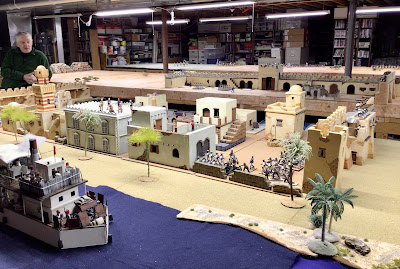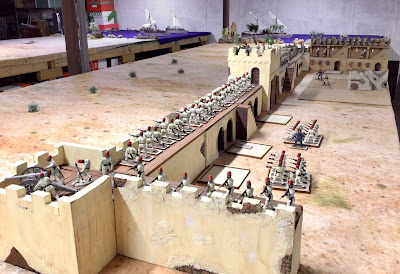 |
| The Cast of Players |
On Saturday March 18, 2023 our band of brothers (all six of us) gathered at the game emporium of Keith L. and played my 54mm Khartoum! game. Keith has a huge basement that holds three 6ft by 32ft game tables , in parallel, resulting in an overall surface area of 18ft by 32ft. The vast expanse of space (including a 6ft wide Nile River) was something to behold. Here are some game pictures, below. Be sure to click and/or double click on the pictures to enlarge the view.
The game featured approximately 200 Egyptian regulars defending the walls of the city of Khartoum against the Dervish army of The Mahdi, all 600 figures. So the attackers had a 3:1 advantage in numbers.
We also had a Dervish river fleet of four dhows and one steam launch facing off against two Egyptian paddle wheel steam boats.
Given the large number of pictures that I have to post of the game, I decided to divide the after action report into two parts. Part 1 will cover the Nile River boat combat and Part 2 will cover the storming of the walls of Khartoum. A few "teaser photos" of the main attack are shown here to wet appetites.
 |
| A view of Khartoum from the Dervish starting positions. |
 |
The Dervish army started on the back table and advanced across the aisle
and on to the center table, where most of the action took place. |
 |
| Khartoum as seen from the banks of the Nile River. |
 |
| Dervish riflemen mill about the oasis next to the river. |
The River BattleThe Dervish navy had a flotilla of four dhow sailboats and one steam launch that towed a barge full of warriors. They were opposed by one of the Egyptian paddle wheel steamers, which was armed with a Krupp 9-pounder forward and a Gatling gun aft, along with a crew of 20 sailors.
 |
| The steam launch towing a barge of Mahdist warriors. |
 |
| The Dervish flotilla sets off upstream towards Khartoum . |
 |
Since the Dervish flotilla outnumbered the Egyptians 5 boats to 1 boat, their strategy
was to overwhelm the paddle wheeler with numbers. Two dhows would attack the
paddle wheeler while the other 3 boats slipped around the bend in the river and
attempted to land in the rear area of Khartoum. |
 |
| Three dhows slip behind the Egyptian boat. |
 |
| The Egyptian captain turned his boat to deliver more fire power at the dhows. |
 |
| A view of the river battle from the walls of Khartoum. |
 |
It looks like the Dervish strategy might pay off as two of their boats slip away
from the Egyptian boat. One dhow has run aground (upper right corner) and
two other dhows have turned back |
OK, so this was a play test and it soon became evident that the naval battle was a lopsided affair with the advantage to the Egyptians. In the end, all of the dhows were run down and destroyed. The Egyptian captain took a few liberties with the maneuvering agility of his paddle wheel boat. I plan to make it harder for the paddle wheeler to turn about. One turn to move forward a length of the boat, one turn to turn left or right , and a third turn to come about and a fourth turn to head upriver. So it will take four turns for the cumbersome paddle wheeler to turn around.
Also, the Egyptian forward Krupp cannon can not be moved in the next game. It has to stay in its forward facing position at all times. I will allow the rear Gatling gun to prolong to the left or right, but this will now take a full turn to accomplish. Three of the dhows have 6-pound cannon forward and they did not move or reposition during the fight. That's the way it should be.
Two dhows and the steam launch (with boat in tow) made it around the bend in the river and headed towards the back door of the city. However, those crafty Egyptians prolonged their artillery on the town walls and took aim on the Dervish fleet. Going forward, I will not allow the Egyptians to prolong their cannons up and down the ramparts willy nilly. The second Egyptian paddle wheeler was docked at Khartoum and it was well positioned to finish off the approaching dhows with its forward Krupp cannon. Again, the paddle wheeler was too maneuverable and flexible. This will change in the next game.
In summary, here are some changes that I am making to the naval rules that are based on the feedback that I got from the play test game.
1. make the paddle wheel boats more cumbersome to maneuver
2. cannons on boats can only face forward and can not be repositioned
3. cannons on the city ramparts can not be prolonged, they have to stay where they are sited
4. work on some ship boarding rules as this is likely to occur during my games
5. give the Egyptians only one armed paddle wheel steamer rather than two
6. add two more dhows to the Dervish flotilla to increase their chances of attacking the city from the river
This is why we play test rules and game scenarios, so I learned a lot about how to run the naval battle on the Nile River.
PART 2 will be posted within the next couple of days.
vvv























































